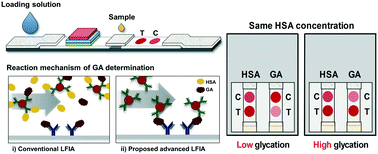Glycation ratio determination through simultaneous detection of human serum albumin and glycated albumin on an advanced lateral flow immunoassay sensor†
Abstract
Glycated albumin synthesized in a non-enzymatic reaction with high glucose levels in human plasma is a long-term biomarker for understanding average glucose levels over the past few weeks. Glycated albumin level determination requires an enzymatic assay involving an expensive, complicated, and laborious process, including the specific hydrolysis of albumin and the oxidation of glycated amino acids. In this study, we developed two advanced lateral flow immunoassays (LFIAs) for the simultaneous determination of total human serum albumin and glycated albumin concentrations using a colorimetric signal. Additionally, through a sequential reaction on our advanced LFIA, the selectivity of glycated albumin was improved. We quantified both HSA and GA with wide detection ranges of 1 ng mL−1–1 mg mL−1 and 0.5 μg mL−1–3.6 mg mL−1, respectively. Various serum samples with different glycation ratios were analyzed using this sensor and demonstrated a reasonable recovery range. This indicated that our platform could directly determinate the glycation ratio of various samples, and therefore, be applicable in point-of-care glucose status monitoring.



 Please wait while we load your content...
Please wait while we load your content...